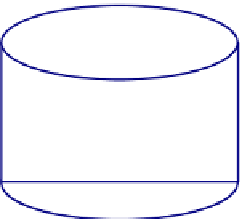Biomedical Engineering Reference
In-Depth Information
carry out Fischer
e
Tropsch synthesis reaction is fed at a syngas rate of 30,000 m
3
/h (STP) at
240
C and 27 atm. The reactor contains 2050 tubes, each of which is 5.0 cm in diameter
and 12 m in length. The iron-based catalyst that fills these tubes usually contains K
2
O and
SiO
2
and has a specific area on the order of 200 m
2
/g. The reaction products are light
hydrocarbons along with a wax that is used in candles and printing inks. Approximately,
50% conversion of the reactant is achieved in the reactor.
5.4. CONTINUOUS STIRRED TANK REACTOR (CSTR)
AND CHEMOSTAT
CSTR is an idealized flow reactor such that all the contents inside the reactor arewell mixed,
just like that in a batch reactor. This idealization makes the flow reactor analysis simplified
extremely as now one can treat the whole reactor as one simple unit or “black box.”
Figure 5.8
shows a schematic of a CSTR. One can observe that the reactor resembles a batch reactor,
however with inlets and outlets attached to it. Since the contents inside the reactor are well
mixed, the concentrations and temperature are identical everywhere inside the reactor and
are equal to those at the outlet. The inlet conditions, on the other hand, can be different.
Mole balance for a given species
j
over the entire reactor leads to
d
n
j
d
t
F
j0
F
j
þ r
j
V ¼
(5.33)
which leads to
d
C
j
d
t
þ C
j
d
V
d
t
F
j0
F
j
þ r
j
V ¼ V
(5.34)
or
d
C
j
d
t
þ C
j
d
V
d
t
Q
0
C
j0
QC
j
þ r
j
V ¼ V
(5.35)
which is the general mole balance equation for a CSTR.
Q
0
,
C
0
,
T
0
C
,
T
Q
,
C
,
T
C
,
T
C
,
T
FIGURE 5.8
Schematic diagram of a CSTR or chemostat showing one stream flowing in and one stream flowing
out of the reactor, with proper volumetric flow rates, temperature, and concentrations.



















Search WWH ::

Custom Search